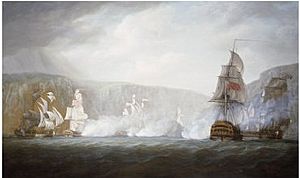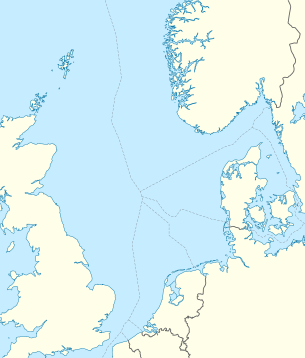Action of 22 August 1795 facts for kids
Quick facts for kids Action of 22 August 1795 |
|||||||
|---|---|---|---|---|---|---|---|
| Part of the French Revolutionary Wars | |||||||
 Defeat of the Dutch Fleet off Egerö, 22 August 1795, Nicholas Pocock, 1795 |
|||||||
|
|||||||
| Belligerents | |||||||
| Commanders and leaders | |||||||
| Strength | |||||||
| 1 ship of the line 3 frigates |
2 frigates 1 cutter |
||||||
| Casualties and losses | |||||||
| 5 killed 18 wounded |
2 killed 15 wounded 1 frigate captured |
||||||
The Action of 22 August 1795 was a small sea battle during the French Revolutionary Wars. It happened between a group of four British Royal Navy ships and three ships from the Batavian Navy. The fight took place near the Norwegian island of Eigerøya. Both sides were trying to protect their trade routes to the Baltic Sea.
War between Britain and the Batavian Republic started without a formal declaration in spring 1795. This happened after France took over the Dutch Republic in January 1795. The British navy leaders, called the Admiralty, ordered British warships to stop Dutch ships.
A British group of four ships, led by Captain James Alms, was patrolling the Skagerrak area. They saw three ships near the Norwegian coast. These ships turned out to be a Batavian group of two frigates and a small cutter. The Batavian ships tried to get away, sailing along the coast. The British ships chased them, trying to cut them off.
At 4:15 PM, the fastest British ship, HMS Stag, caught up with the last Batavian ship, Alliantie. The Stag fought the Alliantie for an hour. Even though the Alliantie was a strong ship, it had to give up. The other Batavian ships, Argo and Vlugheid, managed to escape. They reached the safety of a neutral Danish harbor at Eigerøya.
Contents
Why the Battle Happened
France Takes Over the Netherlands
In the winter of 1794–1795, the armies of France took control of the Dutch Republic. They changed the country into a new state called the Batavian Republic. The Dutch Republic had been an ally of Great Britain against France.
Britain's navy leaders were worried about what happened in the Netherlands. Especially when French soldiers captured the Dutch Navy while its ships were stuck in ice. Because of this, the British ordered their navy to stop Dutch merchant and navy ships. This led to an undeclared war between the Batavian Republic and Great Britain in 1795.
Protecting Trade Routes
To deal with the new Batavian navy, the British Admiralty created a new fleet. This was the North Sea Fleet, led by Admiral Adam Duncan. This fleet was based in Yarmouth, England. It had many older ships, but also faster frigates. These frigates were very important for keeping the Baltic Sea trade routes safe.
Britain got many important supplies for its navy from Scandinavia. So, the trade routes through the Baltic Sea and North Sea were vital. On August 8, 1795, a British group of four ships left The Downs. Their mission was to patrol near the Skagerrak in the Eastern North Sea. This group included:
- 36-gun HMS Reunion (Captain James Alms)
- 32-gun HMS Stag (Captain Joseph Sydney Yorke)
- 50-gun HMS Isis (Captain Robert Watson)
- 28-gun HMS Vestal (Captain Charles White)
The Batavian Navy also needed to protect its trade routes. They sent their own group of ships to the area. This group included the 36-gun frigates Alliantie and Argo, and the 16-gun cutter Vlugheid. On the afternoon of August 22, 1795, the Batavian ships were sailing along the coast of Norway. They were heading southeast when they saw the British ships coming from the south.
The Battle Begins
The Batavian ships were greatly outnumbered by the British. So, they quickly sailed along the coastline. Their goal was to find safety in the neutral Danish harbor of Eigerøya. When Captain Alms saw the Batavian ships, he ordered his group to chase them.
Soon, the fastest British ship, Stag, pulled ahead of the others. It used the wind to its advantage. At 4:15 PM, the Stag managed to cut off the last Batavian ship, Alliantie, from its friends. The Alliantie had 36 guns, which was more than the Stag's 32 guns. However, the Allianties main cannons were smaller (12-pounders) compared to the Stags larger (18-pounder) guns. Also, the rest of the British ships were close by. Because of this, the Alliantie had little chance to win.
The Alliantie Surrenders
Even with the odds against him, the Batavian captain fought the Stag. Captain Yorke brought his ship right next to the Alliantie. The two ships fired their cannons at each other for an hour. By 5:15 PM, the Batavian captain saw that his situation was hopeless. His ship was damaged and outnumbered. He surrendered.
While the Stag and Alliantie were fighting, the chase continued. The other Batavian ships kept sailing east along the Norwegian coast. The British ships tried to cut them off from the channel near Eigerøya. This channel offered protection because it was in neutral Danish waters.
The Vlugheid quickly got away from the British. But the Argo was slower. It came under heavy fire from the British ships Reunion and Isis. The Argo was hit about thirty times and had much of its sails and ropes torn. It needed many repairs. In the end, the Batavian ships succeeded. The Vlugheid and Argo safely escaped into the neutral harbor of Eigerøya before Captain Alms could stop them.
Aftermath
After the battle, Captain Alms sent the captured Alliantie back to Britain. He also sent reports to the British Admiralty. He stayed at sea with his ships to finish their patrol.
British casualties included four killed and 13 wounded on Stag. One was killed and three wounded on Reunion. Two were wounded on Isis. Only Vestal had no damage or injuries. We don't know the exact number of Batavian casualties on Alliantie. However, we know that Argo lost two men killed and 15 wounded during the chase. The Batavian ships that escaped stayed in Eigerøya until spring 1796. Then, they successfully returned to the Netherlands.
The Alliantie was bought by the Royal Navy and renamed HMS Alliance. The money from capturing the ship was shared among the British crews. For example, the sailors on Isis shared £240. Over the next few years, Admiral Duncan's fleet successfully protected the North Sea trade routes. In 1797, they won a big victory against the Batavian fleet at the Battle of Camperdown.
Meanwhile, people in the Batavian Republic were very upset. They believed Denmark's neutrality had been broken. They asked Denmark to demand the return of the Alliantie from Britain. The new leader of the Batavian navy, Admiral Jan de Winter, praised the Batavian ships. He confirmed that the Argo had lost two killed and fifteen injured. He also suggested that Batavian ships had captured four British merchant ships in return.
Letters from Dutch officers of the Alliantie showed that they were prisoners of war in England in early 1796. This was because the two nations were now officially at war.
Images for kids
-
Defeat of the Dutch Fleet off Egerö, 22 August 1795, Nicholas Pocock, 1795
-
Plan of engagement between Isis, Reunion, Stag and Vestal and the Dutch frigate Alliantie, 22 Aug 1795; sketch c. 1795, by Nicholas Pocock





